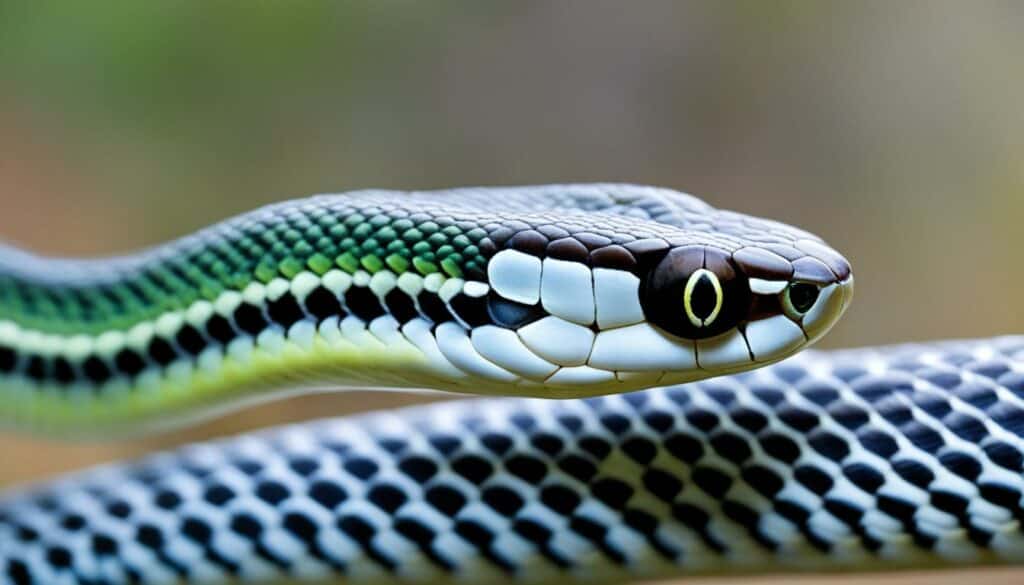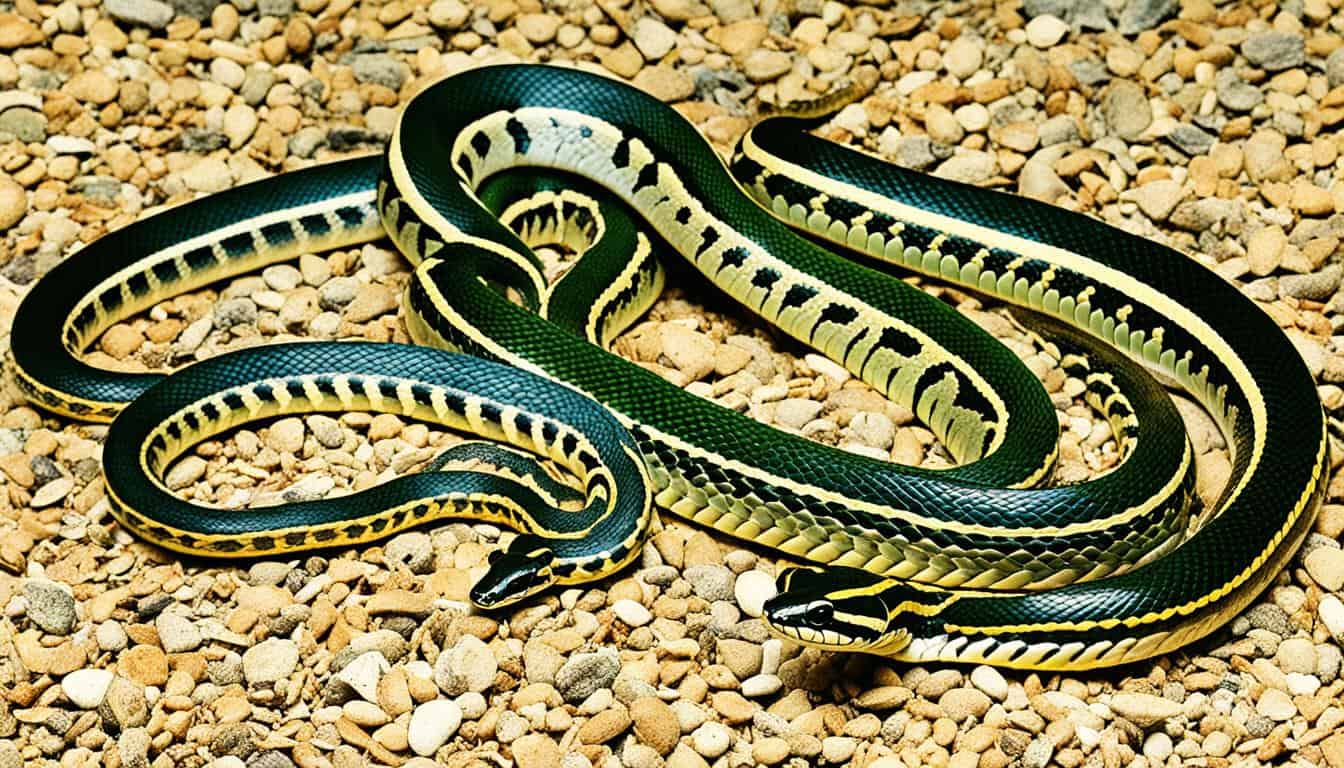Have you ever asked what makes an Eastern Garter Snake different from an Eastern Ribbon Snake? They look alike, especially with their yellow stripes. But, snake identification is key when their homes are the same. People often confuse Garter snakes with “garden snakes.” Garter snakes have less clear, sometimes checkerboard-like stripes. You usually find them in gardens and parks. They can grow up to 54 inches, but are not venomous and shy.
On the other hand, Eastern Ribbon Snakes are long and slim. They have tails that are a big part of their size. Plus, they have a white mark by their eyes that garter snakes don’t. Ribbon snakes love quiet, watery places. This makes telling them apart from garter snakes tricky.
You’ll learn how to tell garter snakes and ribbon snakes apart by the end of this article. It will improve your snake ID skills. You’ll see and enjoy the small but key differences in these interesting creatures.
Introduction to Garter Snakes and Ribbon Snakes
Some folks mix up the Eastern Garter Snake and the Eastern Ribbon Snake because they look alike. This can lead to wrong beliefs.
Common Misconceptions
Many think the Eastern Garter Snake and the Eastern Ribbon Snake are the same. They call them “garden snakes” wrongly. This mix-up can make identifying each snake challenging.
Importance of Accurate Snake Identification
Knowing if it’s a garter snake or a ribbon snake helps the environment. Both eat pests and help keep nature in balance. The Eastern Garter Snake is even honored in Massachusetts. Identifying these snakes correctly reduces fear and supports their care, which is vital now more than ever due to dangers like losing their homes and being wrongly harmed.
Habitat Preferences of Garter Snakes and Ribbon Snakes
Garter and ribbon snakes live in different places, showing us a lot about their lives. Knowing this helps in identifying them correctly. It also helps us understand their role in nature.
Garter Snake Habitats
Garter snakes can make almost any place their home. From gardens to dense forests, meadows, and city parks. They do well even in places changed by people.
This shows how adaptable garter snakes are. They eat a bunch of different things like bugs, frogs, and small animals. Their diet fits their ability to live in many places.
Ribbon Snake Habitats
Ribbon snakes really love the water. They hang out by wetlands, marshes, and lakes. This makes sense since they’re good at swimming and eat things they find in water.
Because they need water, ribbon snakes are harder to see than garter snakes. Garter snakes are everywhere, but ribbon snakes are a bit more hidden.
Physical Characteristics of Garter Snakes
Garter snakes have unique traits that make them stand out in nature. Variations in their body shape, size, and stripes help us tell them apart.
Body Shape and Length
Garter snakes come in different colors like green, brown, and black. They are typically about 20-22 inches long, but some can be up to 54 inches. Remember, they are slender and long, which is key to recognizing them.
Striping Patterns
Garter snake physical description often focuses on their stripes. These snakes have long yellow stripes. Yet, their stripes may sometimes look like checkers, not lines. Knowing these striping details is crucial for telling garter snakes apart from similar species.
Distinct Features of Ribbon Snakes
The ribbon snake stands out with unique traits from its relatives. It has a slim body and a long tail that make it easily recognizable.
Tail Length and Body Shape
Ribbon snake characteristics include a long tail, about one-third their body length. This long tail helps them move quickly. It also makes their body look sleek, aiding in both land and water movements.
Unique Markings
Distinct features of ribbon snakes are their special markings. They have a white spot near their eyes. This spot helps tell them apart from similar snakes like the garter snake. Their unmarked labial scales give them a white-lipped look.
These ribbon snake characteristics are key to identifying them. They tell us about the snake’s behavior and where they like to live. Knowing these traits helps us live alongside these amazing snakes.
How to Identify a Garter Snake in the Wild
To spot a garter snake in the wild, pay close attention to its key features. Garter snakes often come in shades of green, brown, or black. One of their major signs is the long, yellow stripes that go along their bodies.
These stripes might even look checkered, but they’re usually yellow. This makes it easier to tell if it’s a garter snake.
Garter snakes live in many places, making them common for those who love the outdoors. You can find them in gardens, parks, forests, and wetlands. By knowing their colors and stripe patterns, you can identify them easily.
| Trait | Description |
|---|---|
| Background Colors | Green, Brown, Black |
| Stripes Pattern | Long Yellow Stripes, occasionally checkered |
| Habitat Range | Gardens, Parks, Forests, Marshlands |
Identifying a Ribbon Snake in Nature

Ribbon Snakes have unique traits that make them stand out. Knowing these helps you spot them in the wild. They have features and actions that are different from other snakes.
Key Identifiers
One big clue is a white mark in front of their eyes. The lack of markings on their lips makes their face look white-lipped. They also have slim bodies and long tails, which are about a third of their overall length.
Behavioral Patterns
Ribbon Snakes are often near water. Their love for wetlands and their excellent swimming skills are key signs to look for. You can tell them apart by these behaviors which show they are built for water life.
| Ribbon Snake Key Features | Behaviors |
|---|---|
| White mark in front of the eye | Prefers wetland habitats |
| Unmarked labial scales | Proficient swimmer |
| Slender body with long tail | Elusive behavior |
How do you distinguish between a garter snake and a ribbon snake?
It’s important to know how to tell garter snakes and ribbon snakes apart. One big difference is in their tails. Ribbon Snakes have tails that are much longer. They can be about one-third the length of their whole body.
Garter Snakes are thicker, while Ribbon Snakes are thinner. This is easy to see and can help you figure out which snake is which. Just look at their shapes.
Look at their faces for clues too. Ribbon Snakes have a white spot in front of their eyes. Garter Snakes don’t have this marking. It stands out and makes identification easier.
| Characteristics | Garter Snake | Ribbon Snake |
|---|---|---|
| Tail Length | Shorter | Longer (One-third of body) |
| Body Shape | Robust | Slender |
| Facial Markings | None | White spot in front of the eye |
Where they live and how they act can also help in telling them apart. Ribbon Snakes like water. You can usually find them near ponds or in other wet places. Garter Snakes, however, live on land. They are seen in many places including gardens and forests.
Looking at their tail length, body shape, face markings, and where they live, you can figure out if it’s a garter snake or a ribbon snake.
Challenges in Snake Identification for Novices
Identifying snakes can be tough for newbies due to many factors. The biggest issue is telling them apart by how they look and act. It’s hard to know, for example, if a snake is a garter or a ribbon snake without help.
A key challenge is figuring out a snake’s body thickness and tail length. Sometimes, snakes look different because they’re pregnant or injured. This makes it hard to rely on just how they look.
To get better, newbies should learn what makes each snake special. Looking at photos and guides is a big help. Let’s look at some details to make it clearer:
| Factor | Garter Snake | Ribbon Snake |
|---|---|---|
| Body Thickness | Thicker | Slender |
| Tail Length | Short | Long (one-third of body length) |
| Facial Markings | No white mark in front of eye | Distinct white mark in front of eye |
It’s also good to watch where and how snakes live. Garter snakes like land, but ribbon snakes love water. Knowing their homes and habits helps in spotting them correctly.
Benefits of Knowing the Difference Between Garter and Ribbon Snakes
It’s beneficial to tell the difference between Garter Snakes and Ribbon Snakes. Knowing the specifics helps with snake conservation and protecting their environments. These snakes are vital for the environment, controlling pests. Being informed leads to actions that help both species survive.
Understanding Garter and Ribbon snakes also fights false beliefs. This makes talks about snakes more factual and reduces fear. By being able to tell these snakes apart, people and snakes can live in peace. We see the part they play in nature and learn to share the world with them.
Plus, knowing about these snakes makes nature adventures better. Whether you love studying nature or just being outside, you’ll gain from knowing about snake types. This knowledge also encourages efforts to save their homes and protect these interesting reptiles.
FAQ
How do you distinguish between a garter snake and a ribbon snake?
Garter snakes are thicker and have less visible patterns. They don’t have a white mark in front of the eye. Ribbon snakes, meanwhile, are thinner and longer. They show a white mark by their eye.
What are the common misconceptions about garter and ribbon snakes?
Mistaking garter and ribbon snakes happens a lot because of their looks. It leads to calling them “garden snakes.”
Why is accurate snake identification important?
It’s important to identify snakes correctly. This helps reduce fear and encourages respect for them. It also aids in conserving these important creatures.
Where do garter snakes prefer to live?
Garter snakes live in many places like gardens, forests, and parks. They’re good at adjusting to human-made changes in their homes.
What are the typical habitats of ribbon snakes?
Ribbon snakes love water and are often found near wetlands or streams. They can swim well and hunt for food in the water.
What physical traits can help identify a garter snake?
Look for colors ranging from green to black and long yellow stripes. They can be up to 54 inches long and might have checkered patterns.
What are the distinguishing features of ribbon snakes?
Ribbon snakes have long, thin bodies with long tails. They have a white mark by their eyes and white-lipped scales.
How can you identify a garter snake in the wild?
Garter snakes stand out with their green, brown, or black color. They have long, usually yellow, stripes. These stripes sometimes look like checks.
What key features should you look for to identify a ribbon snake?
Look for a white mark in front of their eye. Notice their long bodies and tails. They love living near water and are great swimmers.
What challenges do novices face in identifying garter and ribbon snakes?
It’s hard for newbies to judge by body thickness and tail length. Spotting mistaken signs like pregnancy or injury can also make it tough.
What are the benefits of knowing the difference between garter and ribbon snakes?
Knowing the difference is good for snake protection and respecting them. It helps dispel false ideas and supports living together with these creatures.







